BGP Labs: Set BGP Communities on Outgoing Updates
It’s hard to influence the behavior of someone with strong opinions (just ask any parent with a screaming toddler), and trying to persuade an upstream ISP not to send the traffic over a backup link is no exception – sometimes even AS path prepending is not a strong enough argument.
An easy solution to this problem was proposed in 1990s – what if we could attach some extra attributes (called communities just to confuse everyone) to BGP updates and use them to tell adjacent autonomous systems to lower their BGP local preference? You can practice doing that in the Attach BGP Communities to Outgoing BGP Updates lab exercise.
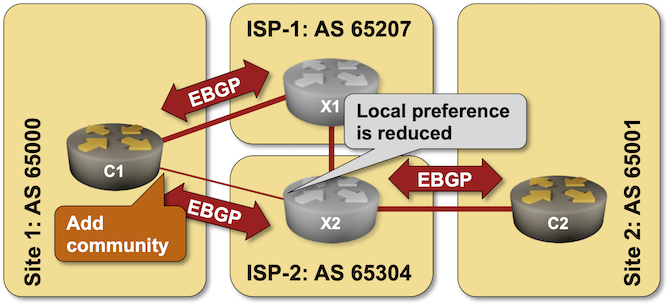
BGP Labs: Use BGP Route Reflectors
In the previous BGP labs, we built a network with two adjacent BGP routers and a larger transit network using IBGP. Now let’s make our transit network scalable with BGP route reflectors, this time using a slightly larger network:
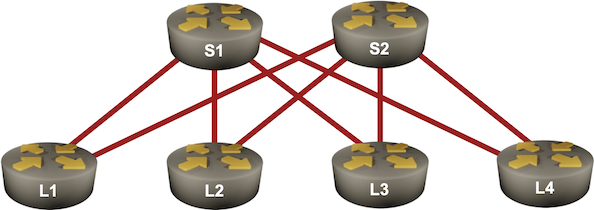
BGP Labs: Use BGP Communities in a Routing Policy
A previous BGP lab focused on the customer side of BGP communities: adding them to BGP updates to influence upstream ISP behavior. Today’s lab focuses on the ISP side of the equation: using BGP communities in a routing policy to implement RFC 1998-style behavior.
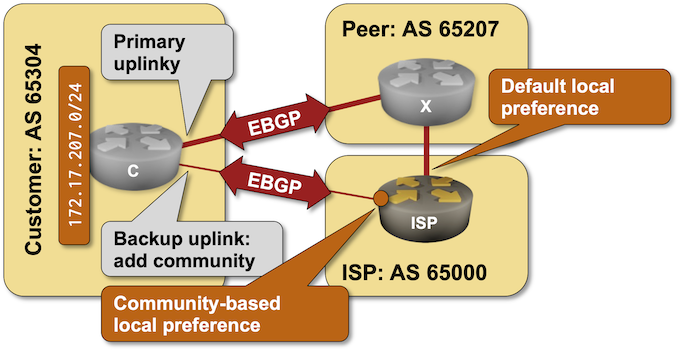
BGP Challenge: Merge Autonomous Systems
Here’s a challenge in case you get bored during the Christmas break: merge two networks running BGP (two autonomous systems) without changing anything but the configurations of the routers connecting them (the red BGP session in the diagram). I won’t give you any hints; you can discuss it in the comments or a GitHub discussion.

Hopefully, you won’t have to deal with something similar in real life, but then we know that crazy requirements trump good designs any day of the week.
BGP Labs: Reuse BGP AS Number Across Sites
When I published the Bidirectional Route Redistribution lab exercise, some readers were quick to point out that you’ll probably have to reuse the same AS number across multiple sites in a real-life MPLS/VPN deployment. That’s what you can practice in today’s lab exercise – an MPLS/VPN service provider allocated the same BGP AS number to all your sites and expects you to deal with the aftermath.

BGP Labs: Work with FRR and Cumulus Linux
FRR or (pre-NVUE) Cumulus Linux are the best bets if you want to run BGP labs in a resource-constrained environment like your laptop or a small public cloud instance. However, they both behave a bit differently from what one might expect from a networking device, including:
- Interfaces are created through standard Linux tools;
- You have to start the FRR management CLI from the Linux shell;
- If you need a routing daemon (for example, the BGP daemon), you must enable it in the FRR configuration file and restart FRR.
A new lab exercise covers these intricate details and will help you get fluent in configuring BGP on FRR or Cumulus Linux virtual machines or containers.
BGP Labs: Override Neighbor AS Number in AS Path
When I described the need to turn off the BGP AS-path loop prevention logic in scenarios where a Service Provider expects a customer to reuse the same AS number across multiple sites, someone quipped, “but that should be fixed by the Service Provider, not offloaded to the customer.”
Not surprisingly, there’s a nerd knob for that (AS override), and you can practice it in the next BGP lab exercise: Fix AS-Path in Environments Reusing BGP AS Numbers.

BGP Labs: Use Multiple AS Numbers on the Same Router
Can you use BGP to connect to the global Internet without having a public BGP AS number? Of course, assuming your Internet Service Provider is willing to run BGP with a network using a private AS number. But what happens if you want to connect to two ISPs? It’s ridiculous to expect you’ll be able to persuade them to use the same private AS number.
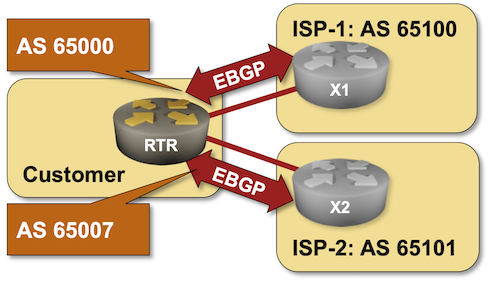
That’s one of the many use cases for the local-as functionality available in most BGP implementations. You can practice it in the Use Multiple AS Numbers on the Same Router lab exercise.
BGP Labs: Session Templates
Configuring an IBGP session on a route reflector takes a half-dozen parameters, starting with the remote BGP AS number (equal to the local one), remote IP address, and the source IP address or interface. You might have to specify the propagation of BGP communities and an MD5 password, and you will definitely have to specify that the BGP neighbor is a route reflector client.
Wouldn’t it be nice if you could group those parameters into a template and apply the template to a neighbor? Most BGP implementations have something along those lines. That feature could be called a session template or a peer group, and you can practice it in the next BGP lab exercise.
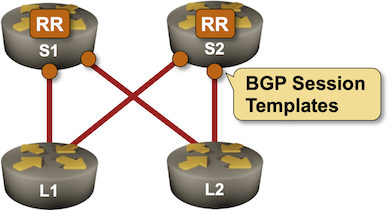
BGP Labs: Remove Private AS from AS-Path
In a previous BGP lab exercise, I described how an Internet Service Provider could run BGP with a customer without the customer having a public BGP AS number. The only drawback of that approach: the private BGP AS number gets into the AS path, and everyone else on the Internet starts giving you dirty looks (or drops your prefixes).
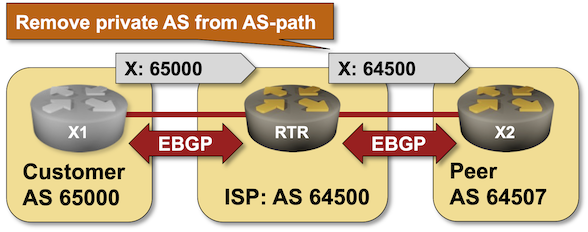
Let’s fix that. Most BGP implementations have some remove private AS functionality that scrubs AS paths during outgoing update processing. You can practice it in the Remove Private BGP AS Numbers from the AS Path lab exercise.
BGP Labs: Policy Templates
One of the previous BGP labs explained how you can use session templates to configure common TCP or BGP session parameters. Some BGP implementations have another templating mechanism: policy templates that you can use to apply consistent routing policy parameters to an EBGP neighbor. You can practice them in the next BGP lab exercise.

BGP Labs: Limit the Number of Accepted BGP Prefixes
Here’s an easy way to stop fat-finger incidents in which an end-user autonomous system redistributes IGP into BGP or advertises the whole DFZ routing table from affecting the entire Internet: limit the number of BGP prefixes your routers accept from your customers. You can practice this nifty feature in the next BGP lab exercise.
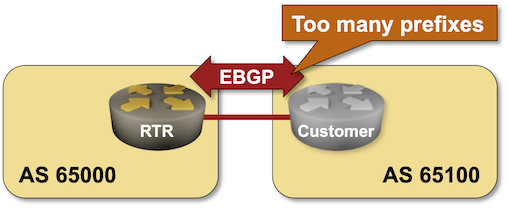
BGP Labs: Stop the Fat-Finger Incidents
Last time, we discussed the first line of defense against fat finger incidents: limiting the number of BGP prefixes your router accepts from a BGP neighbor. However, you can do much more without deploying customer-specific filters (which might require a customer database) or ROV/RPKI.
You can practice the default filters you should always deploy on EBGP sessions with your customers in the Stop the Propagation of Configuration Errors lab exercise.
BGP Labs: Advertise the Default Route
If you’re an Internet Service Provider running BGP with your customers, you might not want to send them the whole Internet routing table. Sending the regional prefixes and the default route is usually good enough.
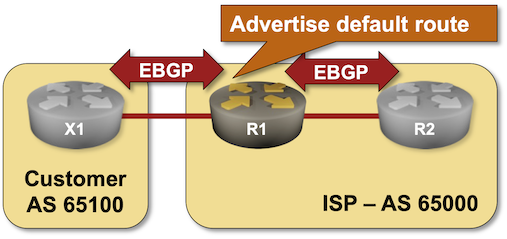
BGP Challenge: Build BGP-Free MPLS Core Network
Here’s another challenge for BGP aficionados: build an MPLS-based transit network without BGP running on core routers.

That should be an easy task if you configured MPLS in the past, so try to spice it up a bit:
- Use SR/MPLS instead of LDP
- Do it on a platform you’re not familiar with (hint: Arista vEOS is a bit different from Cisco IOS)
- Try to get it running on FRR containers.
